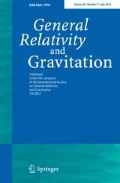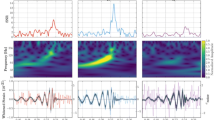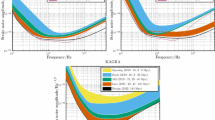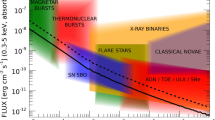Abstract
Gravitational waves (GWs) are expected to play a crucial role in the development of multimessenger astrophysics. The combination of GW observations with other astrophysical triggers, such as from gamma-ray and X-ray satellites, optical/radio telescopes, and neutrino detectors allows us to decipher science that would otherwise be inaccessible. In this paper, we provide a broad review from the multimessenger perspective of the science reach offered by the third generation interferometric GW detectors and by the Einstein Telescope (ET) in particular. We focus on cosmic transients, and base our estimates on the results obtained by ET’s predecessors GEO, LIGO, and Virgo.
Similar content being viewed by others
References
Abbasi R. et al.: Search for high-energy muon neutrinos from the ’naked-eye’ GRB 080319B with the IceCube neutrino telescope. Astrophys. J. 701, 1721–1731 (2009) ArXiv:0902.0131
Alekseev E.N. et al.: Detection of the neutrino signal from SN1987A in the LMC using the INR Baksan underground scintillation telescope. Phys. Rev. Lett. B 205, 209–214 (1988)
Alvarez-Muñiz J., Halzen F., Hooper D.W.: High energy neutrinos from gamma ray bursts: event rates in neutrino telescopes. Phys. Rev. D 62(9), 093015 (2000)
Andersson N., Kokkotas K.D.: Towards gravitational wave asteroseismology. MNRAS 299, 1059–1068 (1998)
Ando S., Beacom J.F.: Revealing the supernova gamma-ray burst connection with TeV neutrinos. Phys. Rev. Lett. 95(6), 061103 (2005)
Ando S., Beacom J.F., Yüksel H.: Detection of neutrinos from supernovae in nearby galaxies. Phys. Rev. Lett. 95(17), 171101 (2005)
Antonioli P. et al.: SNEWS: the SuperNova Early Warning System. New J. Phys. 6, 114 (2004) ArXiv:astro-ph/0406214
Arun K.G. et al.: Massive black-hole binary inspirals: results from the LISA parameter estimation taskforce.. Class. Quantum Gravity 26(9), 094027 (2009)
Aso Y., Márka Z., Finley C., Dwyer J., Kotake K., Márka S.: Search method for coincident events from LIGO and IceCube detectors. Class. Quantum Gravity 25(11), 114039 (2008)
Autiero D. et al.: Large underground, liquid based detectors for astro-particle physics in europe: scientific case and prospects.. JCAP 0711, 011 (2007)
Band D.L. et al.: EXIST’s gamma-ray burst sensitivity. Astrophys. J. 673, 1225–1232 (2008)
Barthelmy S.D. et al.: New soft gamma repeater 0501+4516 was GRB 080822. GRB Coord. Netw. 8113, 1 (2008)
Barwick S.W.: Development of telescopes for extremely energetic neutrinos: AMANDA, ANITA, and ARIANNA.. Nucl. Instrum. Methods Phys. Res. A 602, 279–284 (2009)
Berger E. et al.: A new population of high-redshift short-duration gamma-ray bursts. Astrophys. J. 664, 1000–1010 (2007)
Bionta R.M. et al.: Observation of a neutrino burst in coincidence with supernova SN1987A in the Large Magellanic Cloud. Phys. Rev. Lett. 58, 1494 (1987)
Blair D.G. et al.: The Science benefits and preliminary design of the southern hemisphere gravitational wave detector AIGO. J. Phys. Conf. Ser. 122(1), 012001 (2008)
Bloom J.S. et al.: A putative early-type host galaxy for GRB 060502B: implications for the progenitors of short-duration hard-spectrum bursts. Astrophys. J. 654, 878–884 (2007)
Bloom, J.S., et al.: Astro2010 Decadal survey whitepaper: coordinated science in the gravitational and electromagnetic skies (2009). ArXiv: 0902.1527
Bloom J.S. et al.: Observations of the naked-eye GRB 080319B: implications of nature’s brightest explosion. Astrophys. J. 691, 723–737 (2009)
Burrows A., Livne E., Dessart L., Ott C., Murphy J.: A new mechanism for core-collapse supernova explosions. Astrophys. J. 640, 878–890 (2006) ArXiv:astro-ph/0510687
Campana S. et al.: The shock break-out of GRB 060218/SN 2006aj. Nature 442, 1008–1010 (2006) ArXiv:astro-ph/0603279
Cavalier F. et al.: Reconstruction of source location in a network of gravitational wave interferometric detectors. Phys. Rev. D 74(8), 082004 (2006)
Chapman R., Tanvir N.R., Priddey R.S., Levan A.J.: How common are long gamma-ray bursts in the local Universe. MNRAS 382, L21–L25 (2007)
Chen, P., Hoffman, K.D.: Astro2010 Decadal survey whitepaper: origin and evolution of cosmic accelerators. The unique discovery potential of an UHE neutrino telescope. http://adsabs.harvard.edu/abs/2009astro2010S.43C (2009)
Cobb B.E., Bailyn C.D., van Dokkum P.G., Natarajan P.: SN 2006aj and the nature of low-luminosity gamma-ray bursts. Astrophys. J. 645, L113–L116 (2006)
Corsi, A., Owen, B.J.: A theoretical framework for LIGO-Virgo SGR searches: exploring Ioka’s 2001 model. Tech. Rep. LIGO DCC Document T0900242 and VIR-0028A-09, LSC and Virgo collaboration (2009)
Dalal N., Holz D.E., Hughes S.A., Jain B.: Short GRB and binary black hole standard sirens as a probe of dark energy. Phys. Rev. D 74(6), 063006 (2006)
Davies M.B., King A., Rosswog S., Wynn G.: Gamma-ray bursts, supernova kicks, and gravitational radiation. Astrophys. J. 579, L63–L66 (2002)
de Bellefon, A., et al. MEMPHYS: a large scale water Cerenkov detector at Fréjus (2006). Arxiv: hep-ex/0607026
de Freitas Pacheco J.A.: Do soft gamma repeaters emit gravitational waves. Astron. Astrophys. 336, 397–401 (1998)
Drenkhahn G., Spruit H.C.: Efficient acceleration and radiation in Poynting flux powered GRB outflows. Astron. Astrophys. 391, 1141–1153 (2002)
Duez M.D., Liu Y.T., Shapiro S.L., Stephens B.C.: Excitation of magnetohydrodynamic modes with gravitational waves: a testbed for numerical codes. Phys. Rev. D 72(2), 024029 (2005)
Etienne Z.B., Liu Y.T., Shapiro S.L., Baumgarte T.W.: General relativistic simulations of black-hole–neutron-star mergers: effects of black-hole spin. Phys. Rev. D 79(4), 044024 (2009)
Fairhurst S.: Triangulation of gravitational wave sources with a network of detectors. NJP 11, 123006 (2009)
Fulgione W.: Status of supernova neutrino detectors. J. Phys. Conf. Ser. 203, 012077 (2010)
Gaensler B.M., Chatterjee S.: SGR 0501+4516: proximity to supernova remnant HB9. GRB Coord. Netw. 8149, 1 (2008)
Galama T.J. et al.: Discovery of the peculiar supernova 1998bw in the error box of GRB980425. Nature 395, 670 (1998) ArXiv:astro-ph/9806175
Gehrels N. et al.: A new γ-ray burst classification scheme from GRB060614. Nature 444, 1044–1046 (2006)
Granot J., Ramirez-Ruiz E.: The case for a misaligned relativistic jet from SN 2001em. Astrophys. J. 609, L9–L12 (2004)
Grindlay, J.: GRB Probes of the high-z universe with EXIST. In: Meegan, C., Kouveliotou, C., Gehrels, N. (eds.) American Institute of Physics Conference Series, American Institute of Physics Conference Series, vol. 1133, pp. 18–24 (2009)
Grindlay, J.E.: Yost-swift gamma-ray burst science and capabilities needed to EXIST. In: Holt, S.S., Gehrels, N., Nousek, J.A. (eds.) Gamma-Ray Bursts in the Swift Era. American Institute of Physics Conference Series, vol. 836, pp. 631–641 (2006)
Gupta N., Zhang B.: Neutrino spectra from low and high luminosity populations of gamma ray bursts. Astropart. Phys. 27, 386–391 (2007)
Haiman Z., Kocsis B., Menou K.: The population of viscosity- and gravitational wave-driven supermassive black hole binaries among luminous active galactic nuclei. Astrophys. J. 700, 1952–1969 (2009)
Hansen B.M.S., Lyutikov M.: Radio and X-ray signatures of merging neutron stars. MNRAS 322, 695–701 (2001)
Heise, J., in ’t Zand, J., Kippen, R.M., Woods, P.M.: X-ray flashes and X-ray rich gamma ray bursts. In: Costa, E., Frontera, F., Hjorth, J. (eds.) Gamma-Ray Bursts in the Afterglow Era, p. 16 (2001)
Hild, S., Chelkowski, S., Freise, A.: Pushing towards the ET sensitivity using “conventional” technology. Tech. rep., Einstein Telescope. The official sensitivity curve for ET can be found at http://www.et-gw.eu (section “ET sensitivities”) (2008). ArXiv:0810.0604
Hirata K. et al.: Observation of a neutrino burst from the supernova sn1987a. Phys. Rev. Lett. 58, 1490–1493 (1987)
Hogan, C.J., Schutz, B.F., Cutler, C.J., Hughes, S.A., Holz, D.E. Astro2010 decadal survey whitepaper: precision cosmology with gravitational waves. http://adsabs.harvard.edu/abs/2009astro2010S.130H (2009)
Hogg, D.W.: Distance measures in cosmology (1999). ArXiv: astro-ph/9905116
Holz D.E., Hughes S.A.: Using gravitational-wave standard sirens. Astrophys. J. 629, 15–22 (2005)
Horowitz C.J., Kadau K.: The breaking strain of neutron star crust and gravitational waves. Phys. Rev. Lett. 102, 191102 (2009) ArXiv:0904.1986
Horvath J.E.: Energetics of the superflare from SGR1806-20 and a possible associated gravitational wave burst. Mod. Phys. Lett. A 20, 2799–2804 (2005)
Hughes S.A., Holz D.E.: Cosmology with coalescing massive black holes. Class. Quantum Gravity 20, 65 (2003)
Ioka K.: Magnetic deformation of magnetars for the giant flares of the soft gamma-ray repeaters. Mon. Not. R. Astron. Soc. 327, 639–662 (2001)
Ioka K., Razzaque S., Kobayashi S., Mészáros P.: TeV-PeV neutrinos from giant flares of magnetars and the case of SGR 1806-20. Astrophys. J. 633, 1013–1017 (2005)
Ivezic, Z., et al.: LSST: from science drivers to reference design and anticipated data products (2008). ArXiv: 0805.2366
Jung, C.K.: Feasibility of a next generation underground water Cherenkov detector: UNO (2000). ArXiv: hep-ex/0005046
Kalmus, P.: Search for gravitational wave bursts from soft gamma repeaters. Ph.D. thesis, Columbia University, City of New York (2008)
Kanner J., Huard T.L., Márka S., Murphy D.C., Piscionere J., Reed M., Shawhan P.: LOOC UP locating and observing optical counterparts to gravitational wave bursts. Class. Quantum Gravity 25(18), 184034 (2008)
Kistler, M.D., Yuksel, H., Ando, S., Beacom, J.F., Suzuki, Y. Core-collapse astrophysics with a five-megaton neutrino detector (2008). ArXiv:0810.1959
Kobayashi S., Mészáros P.: Gravitational radiation from gamma-ray burst progenitors. Astrophys. J. 589, 861–870 (2003)
Kocsis B., Frei Z., Haiman Z., Menou K.: Finding the electromagnetic counterparts of cosmological standard sirens. Astrophys. J. 637, 27–37 (2006)
Kocsis B., Loeb A.: Brightening of an accretion disk due to viscous dissipation of gravitational waves during the coalescence of supermassive black holes. Phys. Rev. Lett. 101(4), 041101 (2008)
Kotake K., Sato K., Takahashi K.: Explosion mechanism, neutrino burst and gravitational wave in core-collapse supernovae. Rep. Prog. Phys. 69, 971–1143 (2006)
Kouveliotou C. et al.: Identification of two classes of gamma-ray bursts. Astrophys. J. Lett. 413, L101–L104 (1993)
Kulkarni, S.R., Kasliwal, M.M.: Transients in the local universe (2009). ArXiv:0903.0218
Kulkarni S.R. et al.: Radio emission from the unusual supernova 1998bw and its association with the γ-ray burst of 25 April 1998. Nature 395, 663–669 (1998)
Lazzarini, A., Weiss, R.: LIGO science requirements document. Tech. Rep. LIGO-E950018-02 E, LIGO. http://www.ligo.caltech.edu/docs/E/E950018-02.pdf (1996)
Le T., Dermer C.D.: On the redshift distribution of gamma ray bursts in the swift era. Astrophys. J. 661, 394–415 (2006) ArXiv:astro-ph/0610043
Leahy D.A., Tian W.W.: Radio spectrum and distance of the SNR HB9. A&A 461(3), 1013–1018 (2007)
Lee W.H., Ramirez-Ruiz E.: The progenitors of short gamma-ray bursts. New J. Phys. 9, 17 (2007)
Leonor, I., et al.: Searching for prompt signatures of nearby core-collapse supernovae by a joint analysis of neutrino and gravitational-wave data (2010). ArXiv:1002.1511
Li L.X., Paczyński B.: Transient events from neutron star mergers. Astrophys. J. 507, L59–L62 (1998)
Liang E., Zhang B., Virgili F., Dai Z.G.: Low-luminosity gamma-ray bursts as a unique population: luminosity function, local rate, and beaming factor. Astrophys. J. 662, 1111–1118 (2007)
Lipunov V.M., Panchenko I.E.: Pulsars revived by gravitational waves. Astron. Astrophys. 312, 937–940 (1996)
Lyutikov M., Blackman E.G.: Gamma-ray bursts from unstable Poynting-dominated outflows. MNRAS 321, 177–186 (2001)
Lyutikov M., Blandford R. Gamma ray bursts as electromagnetic outflows (2003). ArXiv:astro-ph/0312347
MacFadyen A.I., Woosley S.E.: Collapsars: gamma-ray bursts and explosions in “failed” supernovae. Astrophys. J. 524, 262–289 (1999)
MacLeod C.L., Hogan C.J.: Precision of Hubble constant derived using black hole binary absolute distances and statistical redshift information. Phys. Rev. D 77(4), 043512 (2008)
Malesani D. et al.: SN 2003lw and GRB 031203: A bright supernova for a faint gamma-ray burst. Astrophys. J. Lett. 609, L5–L8 (2004)
Mazzali P.A. et al.: An asymmetric energetic type Ic supernova viewed off-axis, and a link to gamma ray bursts. Science 308, 1284–1287 (2005)
Mereghetti S.: The strongest cosmic magnets: soft gamma-ray repeaters and anomalous X-ray pulsars. Astron. Astrophys. Rev. 15, 225–287 (2008) ArXiv:0804.0250
Meszaros P.: Gamma-ray bursts. Rep. Prog. Phys. 69, 2259–2322 (2006)
Mirabel I.F., Rodriguez L.F.: Sources of relativistic jets in the Galaxy. Annu. Rev. Astron. Astrophys. 37, 409–442 (1999) ArXiv:astro-ph/9902062
Moortgat, J., Kuijpers, J.: Indirect visibility of gravitational waves in magnetohydrodynamic plasmas (2005). ArXiv:gr-qc/0503074
Murase K., Ioka K., Nagataki S., Nakamura T.: High-energy neutrinos and cosmic rays from low-luminosity gamma-ray bursts. Astrophys. J. 651, L5–L8 (2006)
Nakamura, K.: Hyper-Kamiokande: a next generation water Cherenkov detector. In: Shrock, R. (ed.) Neutrinos and Implications for Physics Beyond the Standard Model. World Scientific, p. 307 (2003)
Nakar E.: Short-hard gamma-ray bursts. Phys. Rep. 442, 166–236 (2007)
Nissanke, S., Hughes, S.A., Holz, D.E., Dalal, N., Sievers, J.L. Exploring short gamma-ray bursts as gravitational-wave standard sirens (2009). ArXiv: 0904.1017
Ott C.D.: The gravitational wave signature of core-collapse supernovae. Class. Quantum Gravity 26, 063001 (2009) ArXiv:0809.0695
Owen B.J.: Maximum elastic deformations of compact stars with exotic equations of state. Phys. Rev. Lett. 95(21), 211101 (2005)
Owen B.J.: How photon astronomy affects searches for continuous gravitational waves. Class. Quantum Gravity 26, 204014 (2009)
Owen, B.J., Reitze, D.H., Whitcomb, S.E. Probing neutron stars with gravitational waves (2009). ArXiv:0903.2603
Perley D.A. et al.: GRB 080503: Implications of a naked short gamma-ray burst dominated by extended emission. Astrophys. J. 696, 1871–1885 (2009)
Phinney E.S. Finding and using electromagnetic counterparts of gravitational wave sources (2009). ArXiv:0903.0098
Pian E. et al.: An optical supernova associated with the X-ray flash XRF 060218. Nature 442, 1011–1013 (2006)
Piran T.: The physics of gamma-ray bursts. Rev. Mod. Phys. 76, 1143–1210 (2005)
Piro A.L., Pfahl E.: Fragmentation of collapsar disks and the production of gravitational waves. Astrophys. J. 658, 1173–1176 (2007)
Pradier T.: Coincidences between gravitational wave interferometers and high energy neutrino telescopes. Nucl. Instrum. Meth. A 602, 268–274 (2009) ArXiv:0807.2562
Punturo, M.: The Virgo sensitivity curve. Tech. Rep. VIR-NOT-PER-1390-51, Virgo note (2004)
Rachen J.P., Mészáros P.: Photohadronic neutrinos from transients in astrophysical sources. Phys. Rev. D 58(12), 123005 (1998)
Sathyaprakash B.S., Schutz, B., Van Den Broeck, C.: Cosmography with the Einstein Telescope (2009). ArXiv: 0906.4151
Schmidt M.: Luminosity function of gamma-ray bursts derived without benefit of redshifts. Astrophys. J. 552, 36–41 (2001)
Schutz B.F.: Determining the Hubble constant from gravitational wave observations. Nature 323, 310 (1986)
Schwartz S.J. et al.: The gamma-ray giant flare from SGR 1806–20: evidence of crustal cracking via initial timescales. Astrophys. J. Lett. 627, L129–L132 (2005)
Segalis E.B., Ori A.: Emission of gravitational radiation from ultrarelativistic sources. Phys. Rev. D 64(6), 064018 (2001)
Sesana A., Gair J., Mandel I., Vecchio A.: Observing gravitational waves from the first generation of black holes. Astrophys. J. 698, L129–L132 (2009)
Shapiro, C., Bacon, D., Hendry, M., Hoyle, B.: Delensing gravitational wave standard sirens with shear and flexion maps (2009)
Shoemaker, D.: Advanced LIGO anticipated sensitivity curves. Tech. Rep. T0900288-v2, LIGO. https://dcc.ligo.org/cgi-bin/DocDB/ShowDocument?docid=2974 (2009)
Soderberg A.M., Frail D.A., Wieringa M.H.: Constraints on off-axis gamma-ray burst jets in type Ibc supernovae from late-time radio observations. Astrophys. J. 607, L13–L16 (2004)
Soderberg A.M. et al.: The sub-energetic γ-ray burst GRB 031203 as a cosmic analogue to the nearby GRB 980425. Nature 430, 648–650 (2004)
Soderberg A.M. et al.: Relativistic ejecta from X-ray flash XRF 060218 and the rate of cosmic explosions. Nature 442, 1014–1017 (2006)
Soderberg, A.M., et al. Discovery of a relativistic supernova without a gamma-ray trigger (2009). ArXiv: 0908.2817
Sokolov V.V.: On the GRB progenitors: possible consequences for supernovae connection with γ-ray bursts. Bull. Special Astrophys. Obs. 51, 38–47 (2001)
Spiering, C.: Status and perspectives of astroparticle physics in Europe (2008). ArXiv: 0804.1500
Strohmayer, T.E., Mushotzky, R.F.: Evidence for an intermediate mass black hole in NGC 5408 X-1 (2009)
Sutton, P.J.: A rule of thumb for the detectability of gravitational-wave bursts. Tech. Rep. LIGO- P1000041-v1, LIGO. https://dcc.ligo.org/cgi-bin/private/DocDB/ShowDocument?docid=10614 (2010)
Suzuki Y.: Multi-megaton water Cherenkov detector for a proton decay search – TITAND (2001). ArXiv:hep-ex/0110005
The icecube collaboration: Achterberg, A. et al., the IPN Collaboration: Hurley, K. et al.: The search for muon neutrinos from northern hemisphere Gamma-ray bursts with AMANDA. Astrophys. J. 674, 357–370 (2008)
The LIGO Scientific Collaboration: Search for gravitational waves associated with the gamma ray burst GRB030329 using the LIGO detectors. Phys. Rev. D. 72(4), 042002 (2005)
The LIGO Scientific Collaboration: Search for gravitational wave radiation associated with the pulsating tail of the SGR 1806-20 hyperflare of 27 December 2004 using LIGO. Phys. Rev. D 76(6), 062003 (2007)
The LIGO Scientific Collaboration: Implications for the origin of GRB 070201 from LIGO observations. Astrophys. J. 681, 1419–1430 (2008)
The LIGO Scientific Collaboration: Search for gravitational-wave bursts from soft gamma repeaters. Phys. Rev. Lett. 101(21), 211102 (2008)
The LIGO Scientific Collaboration: Search for gravitational waves associated with 39 gamma-ray bursts using data from the second, third, and fourth LIGO runs. Phys. Rev. D 77(6), 062004 (2008)
The LIGO Scientific Collaboration: LIGO: the laser interferometer gravitational-wave observatory. Rep. Prog. Phys. 72(7), 076901 (2009)
The LIGO Scientific Collaboration: Stacked search for gravitational waves from the 2006 SGR 1900+14 storm. Astrophys. J. 701, L68–L74 (2009). ArXiv: 0905.0005
The LIGO Scientific Collaboration: Collaboration the Virgo Astrophysically triggered searches for gravitational waves: status and prospects. Class. Quantum Gravity 25(11), 114051 (2008)
The LIGO Scientific Collaboration and the Virgo Collaboration: Search for gravitational-wave bursts associated with gamma-ray bursts using data from LIGO Science Run 5 and Virgo Science Run 1 (2009). ArXiv: 0908.3824
The Virgo Collaboration: Search for gravitational waves associated with GRB 050915a using the Virgo detector. Class. Quantum Gravity 25(22), 225001 (2008)
The Virgo Collaboration: Advanced Virgo baseline design. Tech. Rep. VIR-0027A-09, Virgo. https://tds.ego-gw.it/ql/?c=6589 (2009)
Thompson C., Duncan R.C.: The soft gamma repeaters as very strongly magnetized neutron stars - I. Radiative mechanism for outbursts. MNRAS 275, 255–300 (1995)
Usov V.V., Katz J.I.: Low frequency radio pulses from gamma-ray bursts?. Astron. Astrophys. 364, 655–659 (2000)
van Putten, M.H., et al.: Gravitational radiation from gamma-ray burst-supernovae as observational opportunities for LIGO and Virgo. Phys. Rev. D 69(4), (2004)
Vietri M.: Ultrahigh energy neutrinos from gamma ray bursts. Phys. Rev. Lett. 80, 3690–3693 (1998)
Vietri M., Stella L.: A Gamma-Ray Burst Model with Small Baryon Contamination. Astrophys. J. Lett. 507, L45–L48 (1998)
Wang X.Y., Razzaque S., Mészáros P., Dai Z.G.: High-energy cosmic rays and neutrinos from semirelativistic hypernovae. Phys. Rev. D 76(8), 083009 (2007)
Waxman E.: High energy cosmic-rays and neutrinos from cosmological gamma-ray burst fireballs. Phys. Scripta Vol. T 85, 117 (2000)
Waxman E., Bahcall J.: High energy neutrinos from cosmological gamma-ray burst fireballs. Phys. Rev. Lett. 78, 2292–2295 (1997)
Waxman E., Bahcall J.N.: Neutrino afterglow from gamma-ray bursts: 1018 eV. Astrophys. J. 541, 707–711 (2000)
Wheeler J.C., Yi I., Höflich P., Wang L.: Asymmetric supernovae, pulsars, magnetars, and gamma-ray bursts. Astrophys. J. 537, 810–823 (2000)
Whitcomb, S.E., et al.: Astro2010 decadal survey whitepaper: technology development for third generation ground-based gravitational wave detectors. https://dcc.ligo.org/cgi-bin/DocDB/ShowDocument?docid=1587 (2009)
Woods, P.M., Thompson, C.: Soft gamma repeaters and anomalous X-ray pulsars: magnetar candidates. In: Lewin, W. (ed.) Compact stellar X-ray sources, pp. 547–586. Cambridge University Press (2006)
Woosley S.E.: Gamma-ray bursts from stellar mass accretion disks around black holes. Astrophys. J. 405, 273–277 (1993)
Woosley S.E., Bloom J.S.: The supernova gamma-ray burst connection. Annu. Rev. Astron. Astrophys. 44, 507–556 (2006)
Author information
Authors and Affiliations
Corresponding author
Rights and permissions
About this article
Cite this article
Chassande-Mottin, E., Hendry, M., Sutton, P.J. et al. Multimessenger astronomy with the Einstein Telescope. Gen Relativ Gravit 43, 437–464 (2011). https://doi.org/10.1007/s10714-010-1019-z
Received:
Accepted:
Published:
Issue Date:
DOI: https://doi.org/10.1007/s10714-010-1019-z




